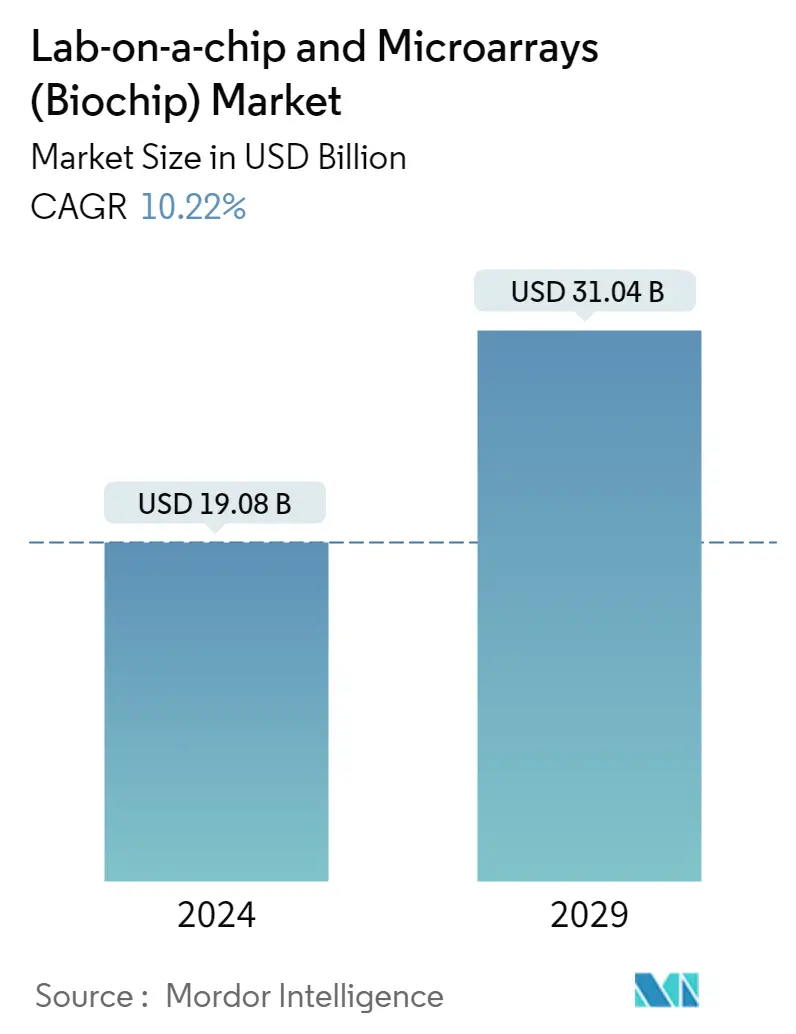Market Size of Lab-on-a-chip and Microarrays (Biochip) Industry

| Study Period | 2021 - 2029 |
| Market Size (2024) | USD 19.08 Billion |
| Market Size (2029) | USD 31.04 Billion |
| CAGR (2024 - 2029) | 10.22 % |
| Fastest Growing Market | Asia Pacific |
| Largest Market | North America |
Major Players
*Disclaimer: Major Players sorted in no particular order |
Need a report that reflects how COVID-19 has impacted this market and its growth?
Lab-on-a-chip and Microarrays Market Analysis
The Lab-on-a-chip and Microarrays Market size is estimated at USD 19.08 billion in 2024, and is expected to reach USD 31.04 billion by 2029, growing at a CAGR of 10.22% during the forecast period (2024-2029).
The COVID-19 pandemic significantly impacted the lab-on-a-chip and microarrays (biochips) market. For instance, an article published by the journal Nature Communication in January 2021 reported that this microarray could be used as a diagnostic tool, as an epidemiologic tool to estimate the disease burden of COVID-19 more accurately, and as a research tool to correlate antibody responses with clinical outcomes. Thus, the COVID-19 pandemic increased the demand for lab-on-a-chip diagnostic tools. However, in the current scenario, it is anticipated that with the presence of other chronic and infectious diseases, the demand for the studied market is expected to increase over the forecast period.
The factors driving the growth of the studied market are increasing demand for point-of-care testing, increasing incidences of chronic diseases, and increasing application of proteomics and genomics in cancer research. Most market players are focusing on the development of new and technologically advanced diagnostic tests. Chronic diseases are the leading cause of death and disability across the world. For instance, an article published by the journal Plos One in March 2022 reported that 21% of the elderly in India had at least one chronic disease. Chronic diseases are the leading causes of disability and mortality among the elderly population in India.
Similarly, another article published by European Public Health Conference in January 2022 reported that more than 3 million people will be affected by cancer by 2030 in Europe. Globally, chronic diseases (CDs) are found to be the leading causes of disability and morbidity. Since those diseases are chronic, accurate and timely clinical decision-making is required. In this direction, research toward developing new lab-on-a-chip-based POC systems for the diagnosis of chronic diseases is an emerging area. Thus, a high incidence of chronic diseases is expected to drive the growth of the studied market.
Biochips are increasingly being used in the field of biomedical and biotechnological research. With the advancement of technologies, there has been a rise in the adoption of biochips in proteomics. The advantages of protein biochips are the low sample consumption due to their inclination toward miniaturization. These characteristics of microarrays are important for proteome-wide analysis. Proteomics is being widely adopted for biomarker and drug discoveries. For instance, in April 2021, PathogenDx Inc. reported that the USFDA had issued an Emergency Use Authorization (EUA) for its patented COVID-19 multiplexed viral diagnostic assay, DetectX-Rv. DetectX-Rv is an RT-PCR and DNA microarray hybridization test intended for the qualitative detection of nucleic acids from SARS-CoV-2 swabs. Thus, such approvals for new products are also contributing to the growth of the studied market.
Thus, due to the increasing demand for point-of-care testing, increasing incidences of chronic diseases, and increasing application of proteomics and genomics in cancer research, the studied market is expected to witness significant growth over the forecast period. However, the design constraints of lab-on-chip technology and the availability of alternative technologies may slow down the growth of the studied market.
